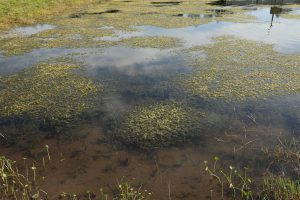Hydrilla, love it or hate it…you must respect it.
At the most basic level, all plants use sunlight to turn nutrients and carbon dioxide into growth. The simple fact is this: some plants grow faster because they are just better at doing these simple things.
Why does hydrilla (Hydrilla verticillata) seem to dominate our waters and out-compete our native plants? It has the same access to the same resources as other plants but just proves to be more efficient at every step.

Early Bird Gets The Worm
Let’s first consider light levels. Light is the only energy input for plants. While humans can choose how much and what type of energy we use (food), plants rely on the sun. So, the name of the game is to take advantage of every drop of sunlight. In this situation, the plant that can get started first – in the early morning hours with the least amount of light – gets a jump on all the other plants.
Basically, “the early bird gets the worm.” Here is where hydrilla has a distinct advantage. It has a very low light compensation point – which is the amount of light required for the plant to start growing. In the early morning, while eelgrass and peppergrass are still sleeping, hydrilla starts to grow. This head start gives hydrilla VIP access to the limited amounts of nutrients and carbon dioxide present in the water, allowing it to essentially grow every morning with no competition. As the sun continues to rise and the native plants finally have enough sunlight to grow, they start their day at a disadvantage having to fight for the limited resources that are left.
If this were the only advantage hydrilla had, it would be a formidable competitor, but it has other light-related tricks.

Red Light v. Blue Light
As you may know, not all light energy is created equal. When we see a rainbow, we see all the different colors in the visible spectrum– from red to blue/purple – and these different colors represent the different levels of energy that light waves possess. Red, on the top of the rainbow, is the lowest energy light and blue/purple on the bottom is the highest energy. Plants can easily use red and blue light but prefer the blue because higher energy light translates into more energy for growth. However, blue light doesn’t penetrate water very well – the blue light makes it a few inches into the water and degrades into low-energy red light. Remember, hydrilla wakes up early and gets the first shot at the available red light. But what it really wants is the high-energy blue light. So, the red light signals the hydrilla to start growing to the surface as quickly as possible.
Grow Towards The Light
Hydrilla has two growth forms: thin sprouts in the deeper water column and topped-out surface growth. To start, a tuber germinates and sends out a thin hydrilla stem. This stem receives red light, triggering the plant to grow upward toward the light source. But as it nears the surface, it starts to perceive the higher-energy blue light. And this was the goal all along – get to the blue light first, then take full advantage of it.
It takes this advantage by branching and spreading across the surface, shading all the other plants below. So, you still have that stalk anchoring the hydrilla in the sediment, but now you have hundreds of stems spread across the water surface, extending far from where that tuber initially sprouted. Eventually, over 80% of the total plant biomass will be in the top foot or two of water, where it can access all the available light. Meanwhile, eelgrass and peppergrass do not have similar growth mechanisms. They simply germinate and march toward the surface, investing just as much plant biomass in the bottom foot of water as they do in the top foot. The result is that these plants are slower to reach the surface and are often outpaced by hydrilla.
Hydrilla is an amazing plant that is specifically adapted for growth and expansion. Whether it is the ability to take advantage of low light or the ability to discern different wavelengths, this plant knows how to position itself for success. So regardless of whether you love or hate hydrilla, you have to respect and appreciate this incredibly interesting plant.
Learn More About Hydrilla
To learn more about hydrilla, check out our podcast, “Working In The Weeds,” where we talk about all things aquatic and invasive plants. In our “Hydrilla Deep Dive (Part 1)” episode, we discuss this plant structure, photosynthesis, pros vs. cons, and more. Subscribe to our podcast for more episodes on all things invasive and aquatic plants.
This blog post was written by Dr. Jason Ferrell, UF/IFAS CAIP director and professor. Questions or comments can be sent to the UF/IFAS CAIP communications manager at caip@ifas.ufl.edu. Follow UF/IFAS CAIP on Instagram, Facebook, and Twitter. Subscribe for more blogs like this one.
UF/IFAS Center for Aquatic and Invasive Plants. Turning Science Into Solutions.
Did you find this post helpful? Click the heart below!
 5
5
